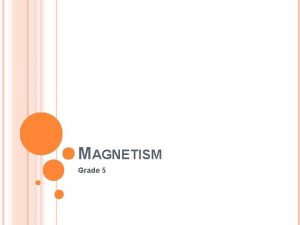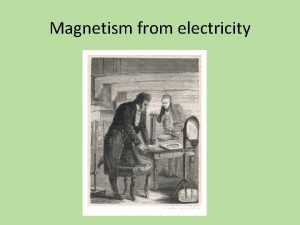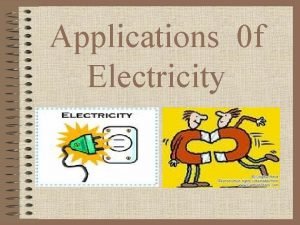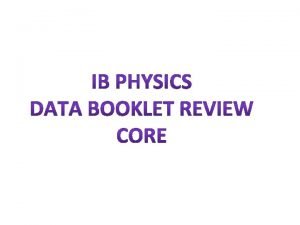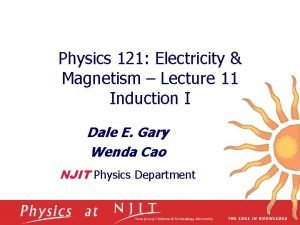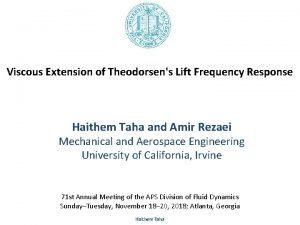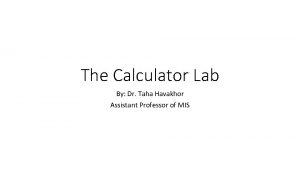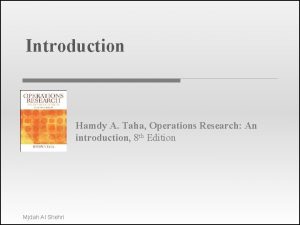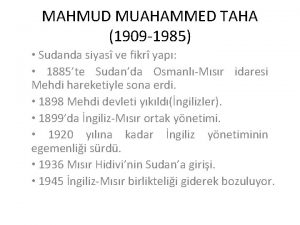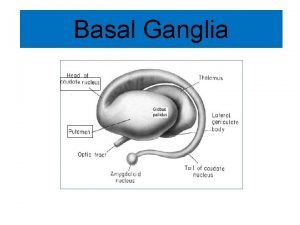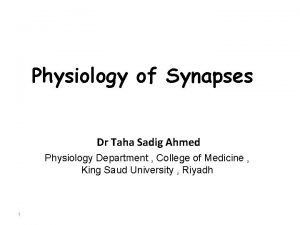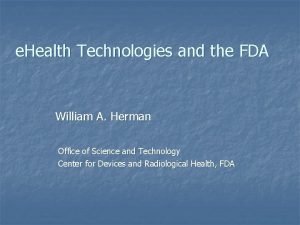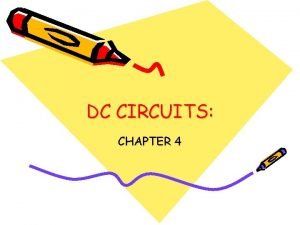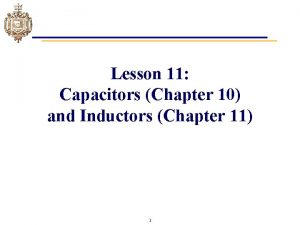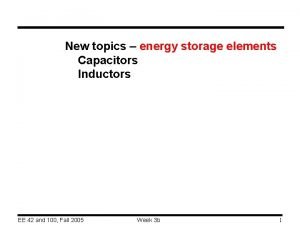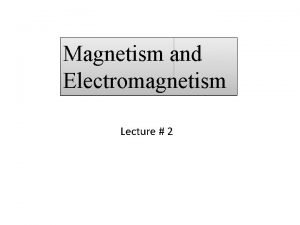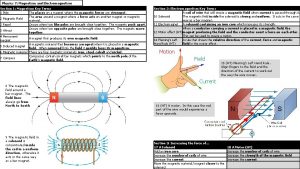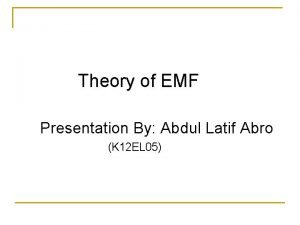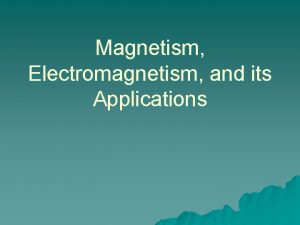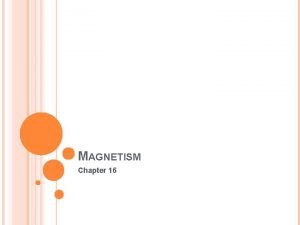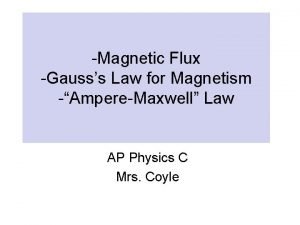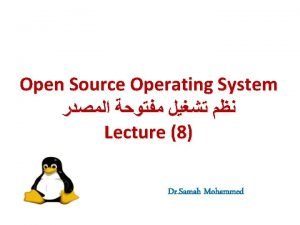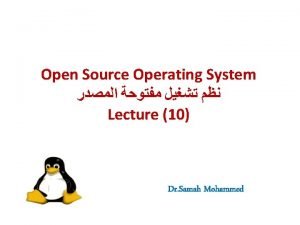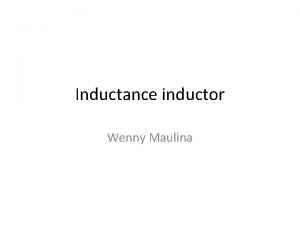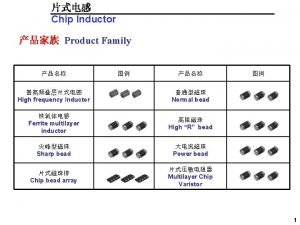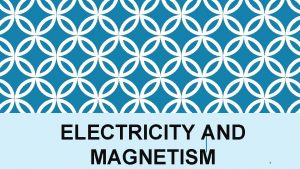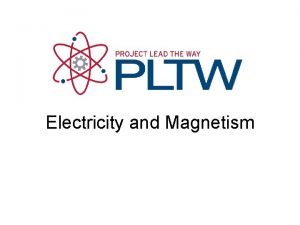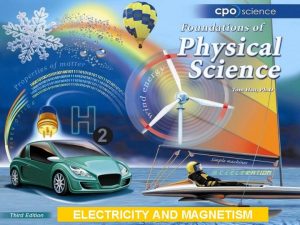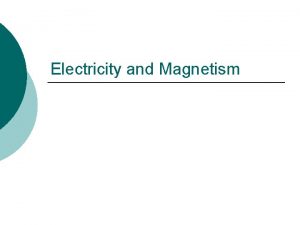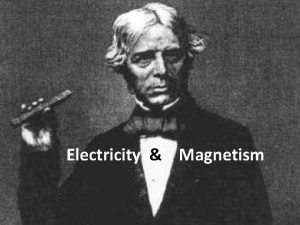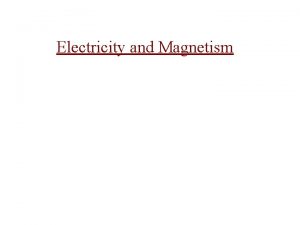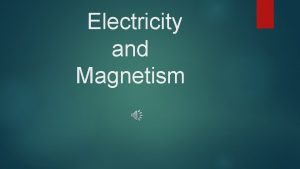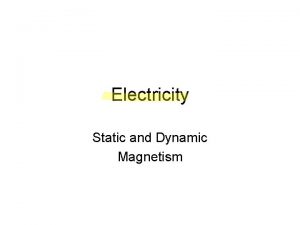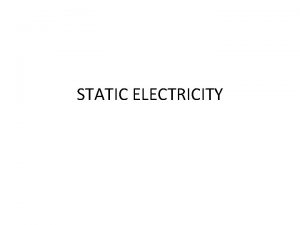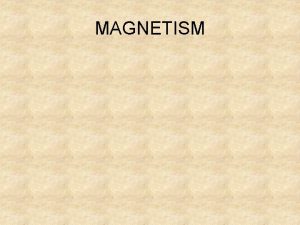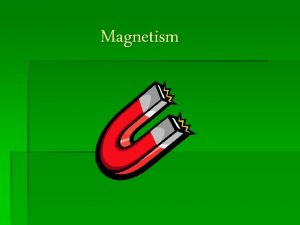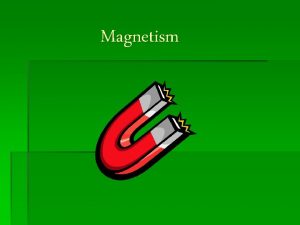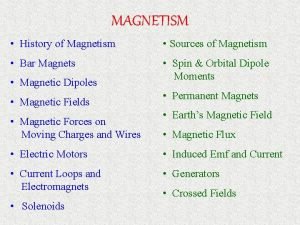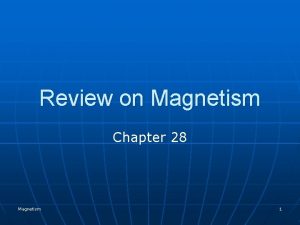Electricity Magnetism Induction and Inductor Mohammed Q Taha










































- Slides: 42

Electricity & Magnetism Induction and Inductor Mohammed Q. Taha

Faraday’s Law AC Circuits The electric current can give rise to a magnetic field, and that a magnetic field can exert a force on a moving charge. I wonder if a magnetic field can somehow give rise to an electric current…

A magnet may move through a loop of wire, or a loop of wire may be moved through a magnetic field (as suggested in the previous slide). These involve observable motion. http: //hyperphysics. phyastr. gsu. edu/hbase/electric/farlaw 2. html# c 1 hbase/electric/farlaw 2. html#c 1

B A Mathematically, magnetic flux B through a surface of area A is defined by B = B A cos B = B A where B is the component of field perpendicular to the surface, A is the area of the surface, and is the angle between B and the normal to the surface. B B A

B When B is parallel to the surface, =90° and B = 0. A B =0 When B is perpendicular to the surface, =0° and B = BA. =0 A B The unit of magnetic flux is the T m 2, called a weber: 1 Wb = 1 T m 2.

In the following discussion, we switch from talking about surfaces in a magnetic field… …to talking about loops of wire in a magnetic field.

Now we can quantify the induced emf described qualitatively in the previous section Experimentally, if the flux through N loops of wire changes by an amount B in a time t, the induced emf is Not an OSE—not quite yet. This is called Faraday’s law of induction. It is one of the fundamental laws of electricity and magnetism, and an important component of theory that explains electricity and magnetism.

Experimentally… an induced emf always gives rise to a current whose magnetic field opposes the change in flux—Lenz’s law. * Think of the current resulting from the induced emf as “trying” to maintain the status quo—to prevent change. *We’ll practice with this in a bit.

Ways to induce an emf: B = B A change B change A the area of the loop in the field

Ways to induce an emf (continued): Changing The Angle by change the orientation of the loop in the field

Conceptual example: Induction Stove An ac current in a coil in the stove top produces a changing magnetic field at the bottom of a metal pan. The changing magnetic field gives rise to a current in the bottom of the pan. Because the pan has resistance, the current heats the pan. If the coil in the stove has low resistance it doesn’t get hot but the pan does. An insulator won’t heat up on an induction stove. Remember the controversy about cancer from power lines a few years back? Careful studies showed no harmful effect. Nevertheless, some believe induction stoves are hazardous.

Conceptual example 21 -2 Practice with Lenz’s Law In which direction is the current induced in the coil for each situation shown? (no current)

(counterclockwise) Rotating the coil about the vertical diameter by pulling the left side toward the reader and pushing the right side away from the reader in a magnetic field that points from right to left in the plane of the page. Remember Now that we are experts on the application of Lenz’s law, lets make our induced emf equation official: This means it is up to you to use Lenz’s law to figure out the direction of the induced current (or the direction of whatever the problem wants.

Example 21 -3 Pulling a Coil from a Magnetic Field A square coil of side 5 cm contains 100 loops and is positioned perpendicular to a uniform 0. 6 T magnetic field. It is quickly and uniformly pulled from the field (moving to B) to a region where the field drops abruptly to zero. It takes 0. 10 s to remove the coil, whose resistance is 100 . 5 cm B = 0. 6 T

(a) Find the change in flux through the coil. Initial: Bi = BA. Final: Bf = 0. B = Bf - Bi = 0 - BA = - (0. 6 T) (0. 05 m)2 = - 1. 5 x 10 -3 Wb.

(b) Find the current and emf induced. final initial The current must flow counterclockwise to induce a downward magnetic field (which replaces the “removed” magnetic field).

The induced emf is The induced current is (c) How much energy is dissipated in the coil? Current flows “only*” during the time flux changes. E = Pt = I 2 Rt = (1. 5 x 10 -2 A) (100 ) (0. 1 s) = 2. 3 x 10 -3 J.

(d) What was the average force required? The loop had to be “pulled” out of the magnetic field, so the pulling force did work The flux change occurs only when the coil is in the process of leaving the region of magnetic field. No flux change. No emf. No current. No work (why? ).

Fapplied D Flux changes. emf induced. Current flows. Work done.

No flux change. No emf. No current. (No work. )

The energy calculated in part (c) is the energy dissipated in the coils while the current is flowing. The amount calculated in part (c) is also the mechanical energy put into the system by the force. 0 Ef – Ei = [ Wother]I f Ef – E i = F D F = Ef / D See 2 slides back for F and D. F = (2. 3 x 10 -3 J) / (0. 05 m) F = 0. 046 N

Induced electric fields To change the magnetic flux we can change: 1. the magnitude B of the magnetic field within the coil 2. the area of the coil, or the portion of that area that lies within the magnetic field (eg expanding the coil or moving it in or out of the field) 3. the angle between the direction of the field B and the area of the coil (eg by rotation of the coil)

Closed and open circuits An induced emf does not necessarily mean an induced current Bin increasing in strength Voltage across the gap = induced emf

Increasing the strength of the magnetic field at a steady rate Þ Faraday’s law Induced emf and induced current appear in ring Þ Lenz’s law Induced current is anticlockwise The electric field is induced even if there is no copper ring

As long as the magnetic field is increasing with time, the electric field will be present as circular lines (by symmetry). If the magnetic field is constant with time, there will be no electric field lines. A changing magnetic field produces an electric field If the magnetic field is decreasing with time, the electric field lines will be circles in the opposite direction

Another way of stating Faraday’s Law B changing Consider a particle of charge q 0 moving around the circular path in figure. The work done in one revolution by the induced electric field is q 0, where is the induced emf, ie the work done per unit charge in moving the test charge around the path.

Another way of stating Faraday’s Law We can now expand the meaning of induced emf. This means that an induced emf can exist without the need for a current or a particle; it is the sum (by integration) of E. dl around a closed path. Which of the red loops has the largest induced emf? Faraday’s Law

Two sorts of electric fields Electrostatic (conservative) Non-electrostatic (non-conservative)

Maxwell hypothesised the existence of induced magnetic fields

A self-sustaining electromagnetic wave


Mutual inductance • occurs when a changing current in one circuit results, via changing magnetic flux, in an induced emf and thus a current in an adjacent circuit. • Mutual inductance occurs because some of the magnetic flux produced by one circuit passes through the other circuit.

Transformers and power supplies • A transformer is a pair of coils linked by mutual inductance. • An AC current in the primary induces a current in the secondary. • The secondary voltage differs from the primary voltage by the ratio of the number of turns. • Both step-up and step-down transformers are possible. • Transformers are used to produce low voltages for electronic equipment. • Then they’re combined with diodes that convert AC to DC and capacitors to smooth the DC voltage.

Transformers and power transmission • Electric power is most efficiently transmitted at high voltages. • This reduces I 2 R energy losses in the power lines. • But most end uses require lower voltages. • Transformers accomplish voltage changes throughout the power grid.

Inductance The current i in the circuit causes a magnetic field B in the coil and hence a flux through the coil. When the current changes, the flux changes also and a self-induced emf appears.

Inductance The magnetic flux through a circuit is related to the current in that circuit and in other circuits nearby. For a coil carrying current I, there is a magnetic field produced around it. The value of B at each point is proportional to the current. Therefore the magnetic flux through the coil is also proportional to I: Constant of proportionality

The potential difference across an Inductor


Inductance

Magnetic Energy

Magnetic Energy What is the energy density stored in an inductor? Homework: Find this for a solenoid with N turns, area A, and length l.

This is how spark plugs work. The car’s generator sends a large current through the coil (inductor). A switch in the distributor is suddenly opened, breaking the current. The induced voltage, usually a few 1000 V, appears across the terminals of the spark plug, creating the spark that ignites the fuel.
 Physics 102
Physics 102 Ib physics electricity and magnetism
Ib physics electricity and magnetism Magnetism
Magnetism Magnetism jeopardy
Magnetism jeopardy Sph3u electricity and magnetism
Sph3u electricity and magnetism Electromagnet experiment hypothesis
Electromagnet experiment hypothesis Intensity of magnetisation
Intensity of magnetisation Grade 5 electricity and magnetism
Grade 5 electricity and magnetism Electricity and magnetism
Electricity and magnetism Electricity and magnetism
Electricity and magnetism Electricity and magnetism
Electricity and magnetism Electricity and magnetism
Electricity and magnetism Electricity and magnetism
Electricity and magnetism Electricity and magnetism vocabulary
Electricity and magnetism vocabulary Static electricity and current electricity
Static electricity and current electricity Current electricity
Current electricity Haithem taha
Haithem taha Taha kass-hout
Taha kass-hout Taha hussein challenges
Taha hussein challenges Taha havakhor
Taha havakhor Taha operations research
Taha operations research Mahmud muhammed taha
Mahmud muhammed taha Bg
Bg Sharif taha
Sharif taha Taha kass-hout
Taha kass-hout Renshaw cells
Renshaw cells Taha kass-hout
Taha kass-hout Taha kass-hout
Taha kass-hout Capacitor in dc circuit
Capacitor in dc circuit Capacitor and inductor example problems
Capacitor and inductor example problems Energy storage elements
Energy storage elements Magnetic lines of force
Magnetic lines of force Magnetism and electromagnetism
Magnetism and electromagnetism Solenoid bbc bitesize
Solenoid bbc bitesize Abro orientation
Abro orientation Electromagnetism vs magnetism
Electromagnetism vs magnetism What is magnets
What is magnets Gauss law in magnetism
Gauss law in magnetism Rahaf mohammed video
Rahaf mohammed video Dr nadia mohammed
Dr nadia mohammed Mohammed mona md
Mohammed mona md Source
Source Dr samah mohammed
Dr samah mohammed







